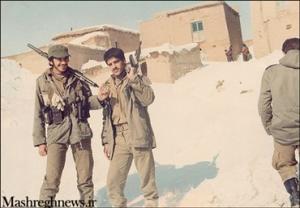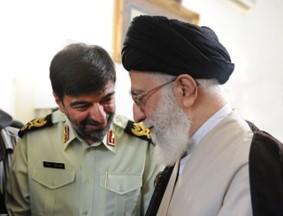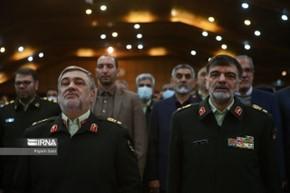Ahmad-Reza Radan: Commander of the Islamic Republic of Iran’s Law Enforcement Command
Download PDFPage Navigation
In January 2023, Iran’s Supreme Leader elevated Ahmad-Reza Radan as the commander of the Islamic Republic of Iran’s Law Enforcement Command (LEC), which is the national police. Radan is a notorious figure, whose career has progressed in tandem with the process of increasing securitization within the Islamic Republic. His ascendance reflects the Iranian system’s desire to suppress the profound revolutionary sentiments among Iranians, and its inability to reform.
Career
 Photo of a young Ahmad-Reza Radan during the Iran-Iraq War
Photo of a young Ahmad-Reza Radan during the Iran-Iraq War
Radan was born in 1963 in Esfahan Province and began his career with service in the Basij and the Islamic Revolutionary Guard Corps (IRGC)—as is tradition among commanders of the Law Enforcement Command (LEC) of the Islamic Republic. He fought during the Iran-Iraq War, and after served as provincial LEC commander in multiple provinces—Kurdistan, Sistan and Baluchestan, Khorasan Razavi, and later Tehran. Radan’s promotion to the senior ranks of LEC—especially the key Tehran commandership—coincided with the election of conservative Mahmoud Ahmadinejad as president in 2005 and his installation of hardline figures in the Interior Ministry which nominally oversees the LEC. At the dawn of Ahmadinejad’s administration, the infamous Morality Police was formed “to spread the culture of modesty and hijab.” In 2007, Radan proclaimed that the police “start…a drive against women who wear improper dress. Tight trousers tucked inside long boots while wearing short overcoats are against Islamic codes. Wearing a hat or cap instead of scarves is also against Islamic dress codes.” That same year, Radan launched a “Public Security Plan”—showcasing arrests and beatings of criminals on camera in front of Tehran residents. He was known for shuttering barber shops over offensive hairstyles.
In recognition of his adherence to Islamic Republic mores and brutality, Radan received another promotion when in 2008 he was named deputy chief of the LEC. It was during his tenure that Radan formed an integral part of the dragnet that suppressed the 2009 Green Movement demonstrations. He not only was part of the top brass of LEC when the crackdown occurred, but also “personally participated in the beatings and ill-treatment of detainees” at the Kahrizak Detention Center. For this record, the U.S. government sanctioned him in 2010. The European Union soon followed by imposing restrictive measures on him in 2011. Radan was such a practiced batterer that Tehran dispatched him to Syria as deputy chief of LEC in April 2011, where he conferred with Syrian authorities and “provided expertise to aid in the Syrian government’s crackdown on the Syrian people,” for which he was sanctioned in 2012.
Radan left his post as the deputy chief of LEC in 2014. After, he became the head of LEC’s Center for Strategic Studies—which was notably outside the chain of command during the presidency of Hassan Rouhani, who was considered more pragmatic than Ahmadinejad, and spoke out publicly against some police excesses saying “you can’t send people to heaven by the whip.” During this period, in 2017, the commander of the LEC in Tehran Hossein Rahimi called for a ”society-oriented, educational approach” to those found to be violating Islamic values. But this amounted to changes in enforcement, which were cosmetic and short-lived. Despite Rouhani’s rhetoric, Khamenei remained in control, with Ayoub Soleimani, Ashtari’s then deputy chief, playing a leading role in suppressing the anti-hijab protests in July 2019. As the U.S. Treasury Department noted in his sanctions designation, “he issued statements that the security forces would forcefully confront women who were not abiding by the Iranian dress code.”
Radan’s career outline is broadly consistent with his predecessor Hossein Ashtari. Both served as deputy LEC chiefs, although Radan had more provincial command experience, whereas Ashtari’s resume included stints steeped in LEC’s public security and intelligence apparatus. Notably, Khamenei decided not to promote Qasem Rezaei, Ashtari’s deputy commander. This stands in contrast to Ashtari’s own direct elevation from deputy commander to commander. Although it is not unprecedented for Khamenei not to elevate a sitting deputy commander—for example, Mohammad Bagher Ghalibaf was announced as LEC commander after serving as commander of the IRGC’s Aerospace Force. Ashtari’s predecessor Esmail Ahmadi-Moghaddam served in a series of command posts of the Basij, including as head of Tehran’s Basij.
 Photo of Ahmad-Reza Radan with Iran’s supreme leader
Photo of Ahmad-Reza Radan with Iran’s supreme leader
This move by the supreme leader likely signaled a desire for Radan’s ideological orientation and skill set. Radan once framed improper hijab as “part of the enemy’s soft war against us.” His ascendance at LEC would demonstrate the Iranian establishment’s desire to more fully reinvigorate the atmosphere that was in place during the Ahmadinejad era. That, combined with Radan’s experience at the helm of multiple provincial LEC commands in restive provinces—where there have been many demonstrations against the Islamic Republic—and his experience during the 2009 Green Movement signals Khamenei’s desire for a more hardened figure in the top LEC job. This comes despite Ashtari’s being very practiced at contending with increasingly intense protests against the Islamic Republic, most notably the demonstrations which were triggered in November 2019 by the Islamic Republic’s decision to raise fuel prices.
Khamenei has reshuffled police commanders amid protests before. In 2000, in the aftermath of student protests in July 1999, Khamenei replaced Hedayat Lotfian with Ghalibaf as LEC chief. There have been indications Khamenei was dissatisfied with the LEC’s performance, even criticizing Ashtari. He hinted at this in Radan’s appointment announcement, highlighting the need for improvements to capabilities, dignity of personnel, and training. In fact, Ashtari served less time in the post—over seven years—than his immediate predecessor, Ahmadi-Moghaddam, who was LEC chief for close to a decade.
Conclusion
 Photo of outgoing LEC Commander Hossein Ashtari and incoming LEC Commander Ahmad-Reza Radan
Photo of outgoing LEC Commander Hossein Ashtari and incoming LEC Commander Ahmad-Reza Radan
Radan’s ascendance is a signal from Khamenei that rather than being serious about responding to the Iranian people’s demands, he is doubling down, fearing compromise begets expectations for more compromise. He will be a reliable, unapologetic lieutenant for Khamenei, who has already had to move beyond the first layer of a police response to the ongoing protests to deploying the Basij and even the IRGC’s Ground Forces in some provinces—the next layers of the Islamic Republic’s security apparatus. Radan will be likely tasked with reinforcing that first flank to compensate for losses since the uprising against the Islamic Republic started in September 2022. The longer the protests continue, the more challenging it will be for the regime to instill discipline and loyalty in the rank-and-file as they are ordered to engage in increasingly abusive suppressive practices.
**This profile has been adapted from UANI Policy Director Jason M. Brodsky’s piece More Signs That Iran Can’t Be Reformed, originally published by 1945 on January 9, 2023.
Receive Iran News in Your Inbox.
Eye on Iran is a news summary from United Against Nuclear Iran (UANI), a section 501(c)(3) organization. Eye on Iran is available to subscribers on a daily basis or weekly basis.
Receive Iran News in Your Inbox
The Iran nuclear deal is done. And the world's biggest companies have already visited Tehran ready to strike a deal when sanctions end. These businesses will add even more to Iran's bottom line. And that means continued development of nuclear technologies and more cash for Hamas and Hezbollah.